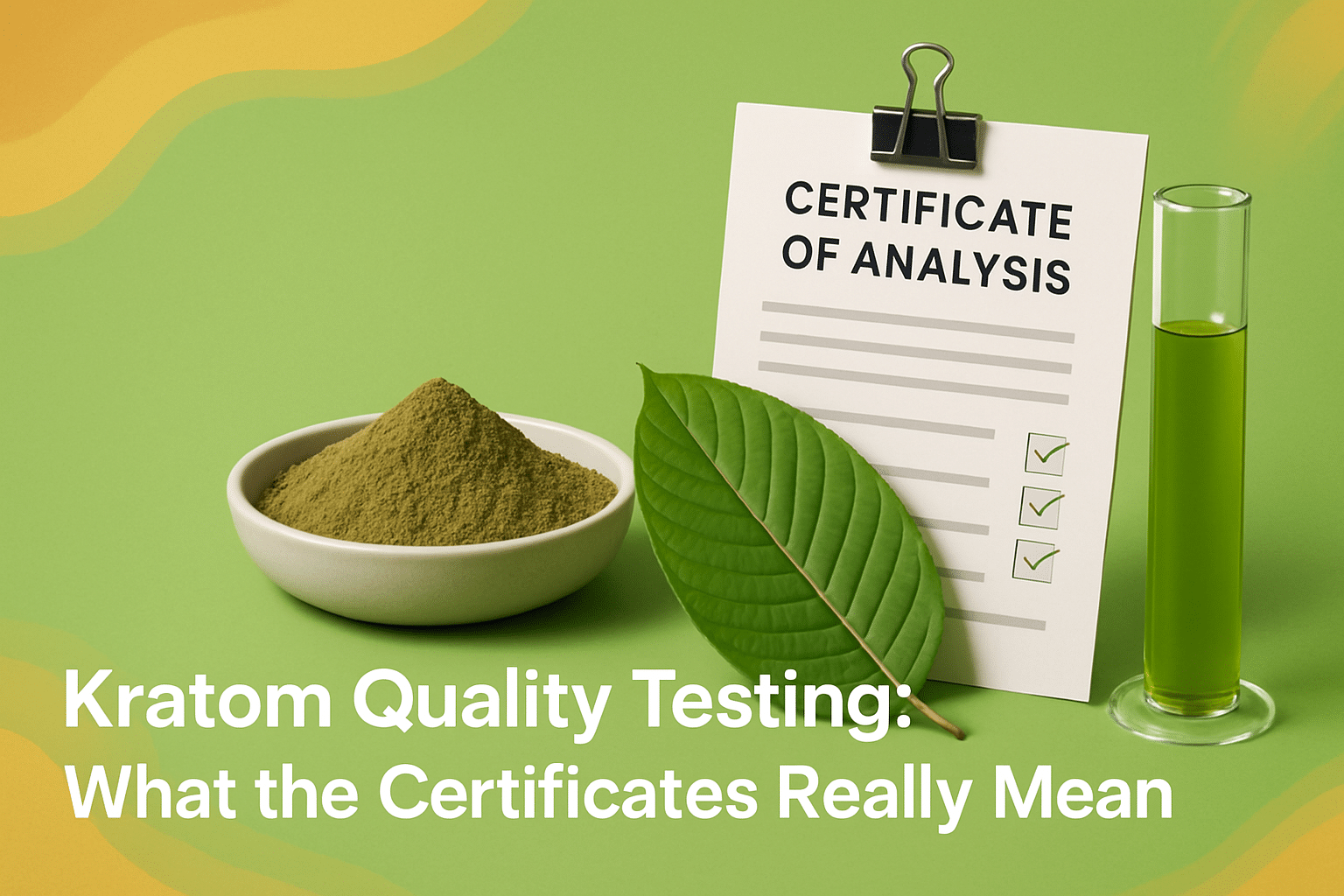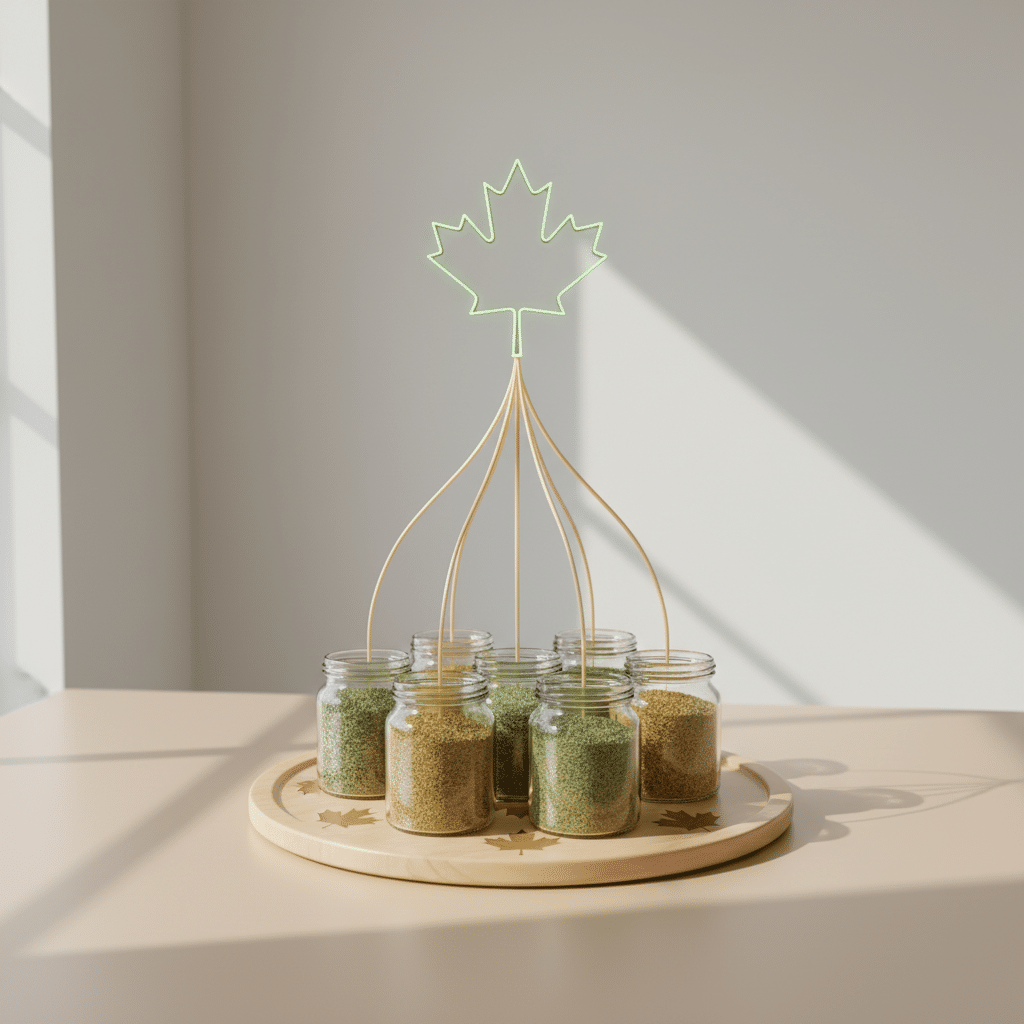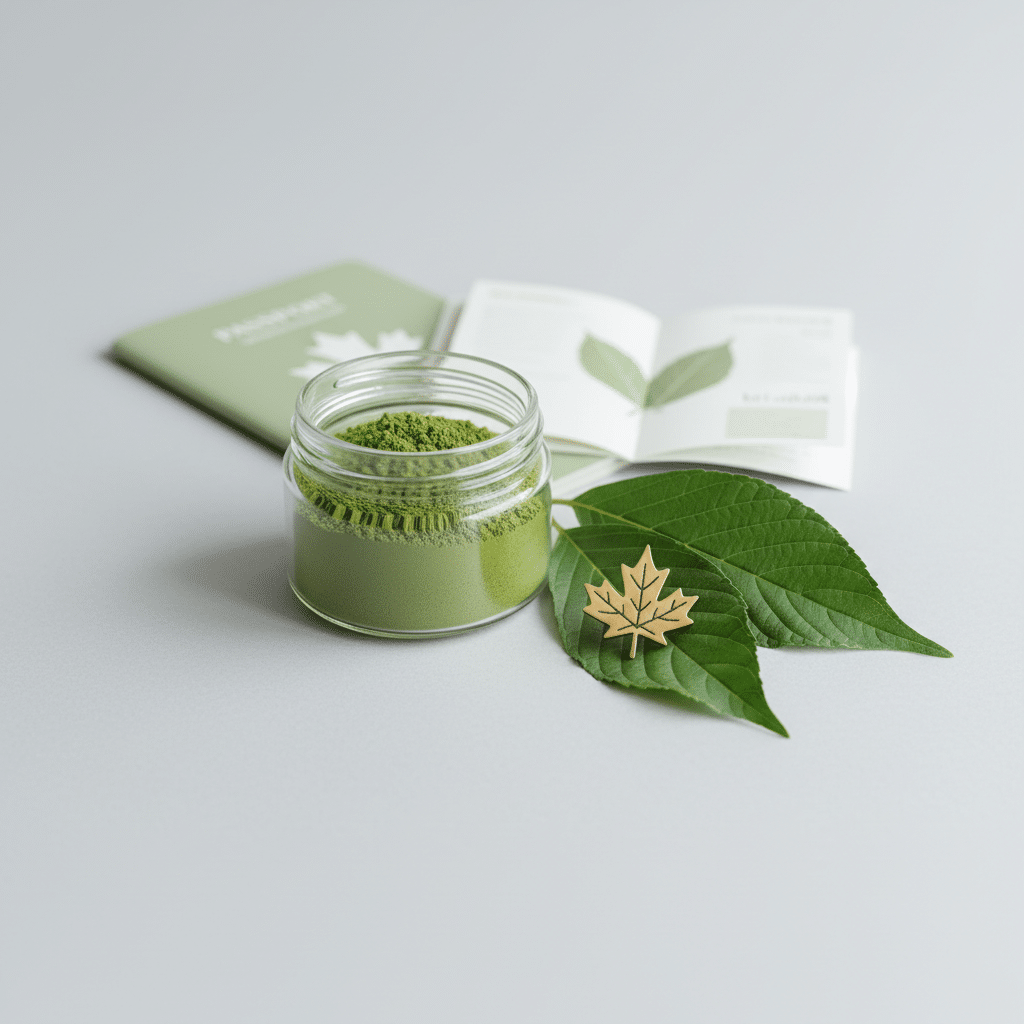
As the kratom market in Canada continues expanding, understanding kratom quality testing has become essential for consumers seeking safe, potent botanical products. Research shows that kratom alkaloid profiles typically show mitragynine concentrations between 1.2-2.0% depending on strain and harvest conditions, making comprehensive testing crucial for product consistency.
Without proper kratom quality testing protocols, consumers risk exposure to contaminants including heavy metals, harmful bacteria, and inconsistent alkaloid levels. This comprehensive guide explains everything Canadian consumers need to know about kratom lab testing standards, Certificate of Analysis (COA) interpretation, and identifying reliable quality documentation.
Whether you’re researching botanical products for examination purposes or seeking to understand Canadian kratom safety standards, this article provides the essential knowledge to make informed decisions about kratom quality verification.
Essential Components of Kratom Lab Testing
Alkaloid Profile Analysis and Potency Measurements
Alkaloid testing forms the foundation of kratom quality assessment. Labs measure primary compounds including mitragynine and 7-hydroxymitragynine to determine product potency and consistency. These measurements help researchers understand the botanical composition and ensure batch-to-batch reliability.
Strain-specific variations significantly impact alkaloid concentrations. Red vein strains typically show different profiles compared to white or green varieties, while harvest timing and processing methods further influence final alkaloid levels. Premium suppliers conduct alkaloid analysis on every production batch.
The natural variation in alkaloid content means that understanding these profiles becomes essential for consistent research applications. Labs use sophisticated equipment to measure these compounds accurately, providing detailed breakdowns of each alkaloid’s presence.
Heavy Metal Contamination Screening
Canadian suppliers must test every batch for heavy metals including arsenic, lead, and cadmium as per Health Canada guidelines for botanical research materials. Heavy metal contamination can occur through soil absorption or processing equipment, making this testing non-negotiable for safety.
Lead exposure poses particular risks, while arsenic and cadmium contamination can accumulate over time with regular use. Testing protocols screen for parts-per-million concentrations of these metals, ensuring levels remain below established safety thresholds.
Premium kratom suppliers implement comprehensive heavy metal screening as standard practice. These tests protect consumers from potentially harmful exposure while maintaining compliance with Canadian safety regulations for botanical products.
Microbial Safety Testing Standards
Microbial contamination testing screens for dangerous bacteria and fungi that can develop during improper storage or processing. Testing for Salmonella, E. coli, and Aspergillus mold is required in every batch, with detection limits enhancing safety for botanical research purposes.
Salmonella and E. coli represent serious health risks if present in consumed botanical products. These pathogens can survive in dried plant material under certain conditions, making thorough testing essential for consumer safety.
Aspergillus mold produces harmful mycotoxins that can cause long-term health issues. Professional testing facilities use specialized culture methods to detect even trace amounts of these dangerous microorganisms before products reach consumers.
Understanding Kratom Purity Certificates
What Purity Percentages Actually Indicate
COA purity percentages often confuse consumers because they don’t represent alkaloid strength. Instead, purity percentages reflect contaminant filtration effectiveness, with premium products achieving >99% organic purity through advanced processing methods.
High purity ratings indicate minimal contamination from foreign materials, processing residues, or environmental pollutants. This measurement focuses on what isn’t present rather than the concentration of desired alkaloids.
Understanding this distinction helps consumers interpret COAs correctly. A 99% purity rating means the product contains less than 1% contaminants, not that it contains 99% active alkaloids.
Interpreting Alkaloid Concentration Data
Alkaloid concentration measurements appear separately from purity ratings on quality COAs. These values show the actual mitragynine and 7-hydroxymitragynine percentages present in each batch.
Natural alkaloid variations depend on growing conditions, harvest timing, and post-harvest processing. Experienced suppliers maintain detailed records of these factors to explain concentration differences between batches.
Quality suppliers provide alkaloid ranges rather than exact percentages, acknowledging the natural variation inherent in botanical products. This transparency indicates honest testing practices and realistic quality expectations.
Laboratory Testing Methods for Kratom Products
HPLC Analysis for Alkaloid Quantification
HPLC (high-performance liquid chromatography) remains the gold standard for measuring mitragynine and 7-hydroxymitragynine concentrations in Canadian lab reports. This sophisticated analytical technique separates individual alkaloids for precise measurement.
HPLC equipment costs hundreds of thousands of dollars, ensuring only serious testing facilities can provide this level of analysis. The method’s accuracy exceeds simpler testing approaches, making it preferred by premium kratom suppliers.
This testing method produces detailed chromatograms showing each alkaloid’s presence and concentration. Professional labs maintain strict calibration standards to ensure consistent, reliable results across different testing sessions.
Mass Spectrometry for Contaminant Detection
Mass spectrometry identifies unknown compounds and verifies the absence of synthetic additives or pharmaceutical contaminants. This advanced technique complements HPLC testing by detecting substances that shouldn’t appear in pure botanical products.
Some unscrupulous suppliers attempt to enhance products with synthetic compounds or pharmaceutical additives. Mass spectrometry testing reveals these adulterants, protecting consumers from potentially dangerous synthetic substances.
The combination of HPLC and mass spectrometry provides comprehensive analysis covering both desired alkaloids and unwanted contaminants. This dual approach represents the highest standard in kratom quality testing.
|
Testing Method |
Purpose |
Detection Capability |
Cost Level |
|---|---|---|---|
|
HPLC |
Alkaloid quantification |
0.01% precision |
High |
|
Mass Spectrometry |
Contaminant identification |
Trace compounds |
Very High |
|
Heavy Metal Analysis |
Metal contamination |
Parts per million |
Medium |
|
Microbial Testing |
Biological safety |
Colony forming units |
Medium |
Red Flags in Kratom Quality Documentation
Missing or Incomplete Test Parameters
COAs must include lab information, testing dates, and batch numbers matching purchase lots – generic reports without these details indicate quality control issues. Legitimate testing requires specific identification linking results to actual products.
Generic COAs without batch-specific information suggest suppliers aren’t conducting real testing. These fake documents often show perfect results across all parameters, which rarely occurs in legitimate botanical testing.
Authentic COAs include the testing laboratory’s contact information, accreditation details, and specific testing methodologies. Missing information in any of these areas raises serious questions about document authenticity.
Suspiciously Perfect Results
Real botanical products show natural variation in alkaloid content and occasionally detect trace contaminants. COAs showing identical results across multiple batches or perfect zero readings for all contaminants often indicate fraudulent documentation.
Legitimate testing reveals the natural inconsistencies present in agricultural products. Seasonal growing conditions, soil variations, and processing differences create measurable variations in authentic test results.
Premium suppliers acknowledge these natural variations in their documentation. They provide realistic ranges rather than claiming impossible consistency across different production batches.
Outdated or Non-Specific Testing Dates
Current kratom quality testing should occur within months, not years, of product sale. Outdated COAs don’t reflect current product quality, while missing dates prevent consumers from assessing result relevance.
Batch-specific testing dates ensure results correspond to actual purchased products. Generic dates or testing performed years earlier provide no meaningful quality assurance for current inventory.
Quality suppliers maintain detailed records linking specific test dates to corresponding product batches. This documentation trail enables consumers to verify they’re receiving recently tested products.
Canadian Standards for Kratom Testing Requirements
Health Canada Guidelines for Botanical Products
While kratom isn’t approved as a natural health product, suppliers must meet botanical safety standards under Health Canada’s Natural Health Products Directorate oversight. These guidelines establish minimum safety requirements for botanical research materials.
Canadian suppliers operate within existing regulatory frameworks governing botanical products sold for research and examination purposes. These regulations emphasize safety testing without specific approval for therapeutic use.
Understanding regulatory distinctions helps consumers appreciate why quality suppliers emphasize research and examination applications. This positioning ensures compliance while maintaining access to properly tested botanical products.
Batch-Specific Testing vs. General Certificates
Premium Canadian suppliers conduct batch-specific testing rather than general product-line certificates to ensure consistent quality across production runs. This approach provides more accurate quality assurance for individual purchases.
Batch-specific testing acknowledges that natural products vary between production runs. Generic certificates assume consistency that doesn’t exist in real botanical processing, providing false security to consumers.
Quality suppliers invest in individual batch testing despite higher costs because it provides genuine quality assurance. This commitment to transparency distinguishes premium suppliers from budget alternatives cutting quality corners.
Third-Party Laboratory Verification
Independent testing facilities provide unbiased analysis without financial incentives to manipulate results. These laboratories maintain professional accreditation and follow standardized testing protocols for botanical products.
Third-party verification eliminates conflicts of interest that might compromise internal testing programs. External laboratories stake their professional reputations on accurate, honest results regardless of client preferences.
Canadian consumers should prioritize suppliers using recognized third-party testing facilities. This approach ensures quality results aren’t influenced by supplier pressure to show favorable outcomes.
Frequently Asked Questions
What should I look for in a legitimate kratom COA?
Legitimate COAs include specific batch numbers, testing dates within the last 6 months, complete lab contact information, and realistic test results showing natural variation. The document should match your specific product batch and include comprehensive safety testing for heavy metals, microbes, and alkaloid content.
How often should kratom batches undergo quality testing?
Quality suppliers test every production batch for safety parameters including heavy metals and microbial contamination. Alkaloid testing may occur less frequently for consistent strains, but safety testing should never be skipped regardless of production volume or cost considerations.
Are Canadian kratom testing standards different from US requirements?
Canadian suppliers follow Health Canada guidelines for botanical products, which emphasize safety testing for research materials. While specific kratom regulations don’t exist, quality suppliers apply pharmaceutical-grade testing standards to ensure consumer safety and regulatory compliance.
What alkaloid levels indicate high-quality kratom products?
Quality kratom typically contains 1.2-2.0% mitragynine and 0.01-0.04% 7-hydroxymitragynine, though natural variation occurs between strains and harvests. Consistent levels within these ranges indicate proper processing and storage rather than specific quality grades.
How can I verify that a COA is authentic and not falsified?
Contact the testing laboratory directly using information from their official website rather than details provided on the COA. Legitimate labs maintain records of all testing performed and can verify specific batch results when contacted by consumers.
What heavy metal levels are considered safe for botanical kratom products?
Canadian safety standards for botanical products specify maximum levels for arsenic, lead, cadmium, and mercury measured in parts per million. Quality suppliers ensure results remain well below these established safety thresholds through careful sourcing and processing controls.
Why do alkaloid levels vary between different batches of the same strain?
Natural agricultural variation affects alkaloid development based on growing conditions, harvest timing, soil quality, and post-harvest processing. Even identical plant genetics produce different alkaloid profiles under varying environmental conditions, making batch testing essential for consistency tracking.
Building Trust Through Transparent Quality Standards
Understanding kratom quality testing empowers Canadian consumers to make informed decisions about botanical products for research and examination purposes. Comprehensive testing protocols covering alkaloid content, heavy metal contamination, and microbial safety provide essential quality assurance.
Premium suppliers invest in batch-specific testing using advanced analytical methods like HPLC analysis and third-party laboratory verification. These quality commitments distinguish reliable suppliers from those cutting corners on safety and transparency.
Quality-conscious consumers should prioritize suppliers providing detailed COAs with current testing dates, specific batch identification, and comprehensive safety screening. This documentation represents genuine commitment to product quality and consumer safety.
Ready to experience premium kratom quality with comprehensive lab testing? Explore 365 Kratom Canada’s collection of tested blends including their signature Sunrise, Clarity, and Relax formulations, each backed by detailed COA documentation.



